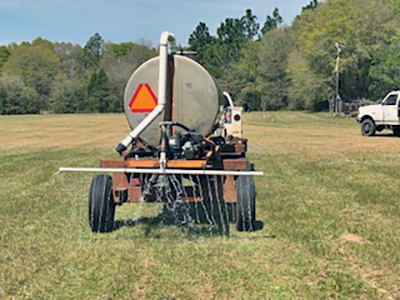Bahiagrass is the most common warm season perennial forage grass in the Florida Panhandle. While its most common use is grazing, there are other ways producers can generate revenue from bahiagrass fields. The most common alternative to grazing is hay production. However, buying hay equipment or contracting someone to bale hay is costly, and the added costs of weed control and fertilizer make it hard to turn a profit. An additional alternative to consider is selling bahiagrass sod. Currently in Walton County, landowners are receiving from $600-$700 per acre for their bahiagrass sod.
 All varieties of bahiagrass are being harvested, with Argentine Bahiagrass being most desirable due to fewer seed heads. The sod being is being used along roadsides, lining the sides of retention ponds, and other sites for erosion control. It is not being used for sodding home sites; centipede, St. Augustine, and Zoysia grass are preferred for these locations.
All varieties of bahiagrass are being harvested, with Argentine Bahiagrass being most desirable due to fewer seed heads. The sod being is being used along roadsides, lining the sides of retention ponds, and other sites for erosion control. It is not being used for sodding home sites; centipede, St. Augustine, and Zoysia grass are preferred for these locations.
Sod is generally being harvested in 100-foot rolls; with some customers’ orders requiring shorter or longer rolls to fit the job site. Sod thickness averages around 2 inches, so very little topsoil is removed. Clean fields are essential before sod harvest. Harvesters don’t want a lot of broomsedge or other grasses mixed in with the Bahiagrass, and are required to avoid fields with noxious weeds.
 During dry conditions, the landowner may need to provide a source of irrigation to water sod before it can be harvested. Established Bahiagrass fields often have roots extending several feet down, so the grass often re-establishes itself in 2-3 years without replanting. To aid in the re-establishment, a narrow grass strip is usually left between harvested strips. After harvest, the landowner can choose to plant an improved variety of Bahiagrass if desired.
During dry conditions, the landowner may need to provide a source of irrigation to water sod before it can be harvested. Established Bahiagrass fields often have roots extending several feet down, so the grass often re-establishes itself in 2-3 years without replanting. To aid in the re-establishment, a narrow grass strip is usually left between harvested strips. After harvest, the landowner can choose to plant an improved variety of Bahiagrass if desired.
Things to consider before selling sod off your farm:
- Make sure you find a reputable sod harvester
- Ensure you will still have enough forage to feed your livestock if sod is harvested
- After sod harvest, many weeds will often sprout and need to be controlled with herbicides
- Fields must be certified noxious weed free with semi-annual inspections for DOT contracts
- Fields must be certified noxious weed free with semi-annual inspections for DOT contracts
- Sod fertilization requirements are different than for grazed pastures to ensure a healthy, dense root system
- Balanced fertilization is required – 120-20-100 (N-P-K for total season, not a single application)
Contact your local extension office for more information and contacts for harvesting sod. The following are some additional resources on using a Bahiagrass sod-based rotation for growing row crops such as cotton and peanuts. While this usually relates to harvesting hay or seed, selling sod during this rotation provides additional income, and removes only a small portion of the biomass as observed by this author.
The Management and Use of Bahiagrass – University of Georgia
Fertility Considerations for Sod Production
Agricultural Management Options for Climate Variability and Change: Sod-Based Rotation
- What are the Benefits of Freezer Beef? - August 27, 2021
- Fire Management in a Silvopasture System - March 19, 2021
- Game Cameras for Wildlife Monitoring - October 2, 2020
